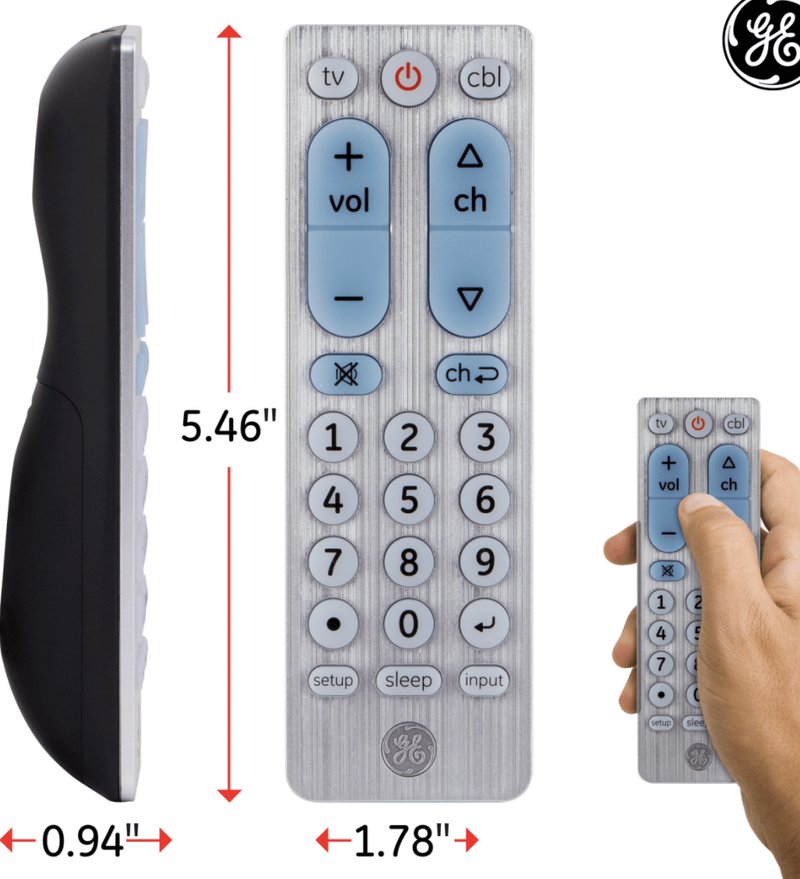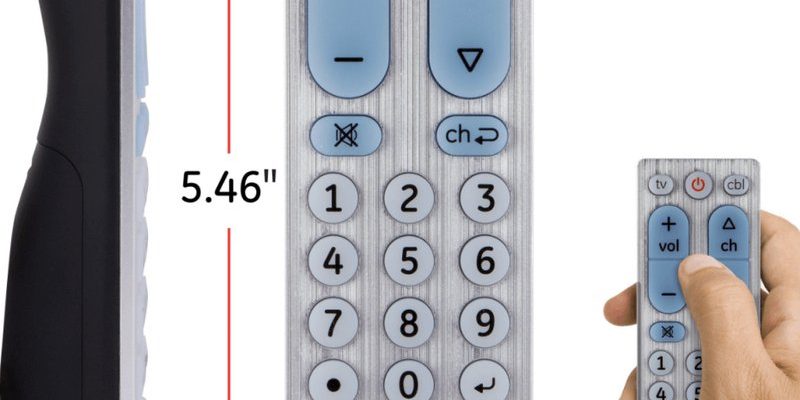
Here’s the thing: a GE Universal Remote is basically the Swiss Army knife of home entertainment. Instead of searching for the right remote (that always seems to have vanished into the couch cushions), you can control almost everything from one sleek gadget. It’s not magic, but honestly, it feels pretty close. GE—yep, the same folks whose name is on everything from light bulbs to fridges—has made these remotes to simplify the chaos.
So, what’s the secret sauce? How can a single remote handle your TV, streaming stick, or ancient DVD player all at once? Let’s walk through how these universal remotes work, and how *you* can set one up at home—even if “programming” sounds as daunting as learning a new language.
What Exactly Is a GE Universal Remote?
If you’re picturing a remote that can somehow morph into whatever you need, you’re not far off. A GE Universal Remote is designed to “learn” the control codes of all your different devices—whether it’s a smart TV, an old-school stereo, or even some game consoles.
Think of it like teaching someone a bunch of new languages. Instead of memorizing how to say “turn up the volume” for ten gadgets, you teach it to one helper (the remote), and it does the translating. These remotes have a giant database of codes built in, covering thousands of brands and models. That’s why you can pair them with so many different devices, even stuff you bought years ago.
Honestly, universal remotes feel like a cheat code for adulthood. They can replace several remotes, which means fewer batteries to buy and fewer things to lose behind the furniture. The fact that it’s GE-branded also means you’re getting something sturdy and well-supported (in my experience, anyway).
How Do GE Universal Remotes Control Multiple Devices?
Alright, so here’s where the magic actually happens. A GE Universal Remote uses something called “device codes.” Every brand and model—whether it’s your TV or sound bar—has a special code. When you enter that code into your universal remote, it *syncs* with the device and starts to speak its language. If you own several devices, you just repeat the process for each one, using the right button or input on the remote as you go.
Let me explain with a mini-story: Say you’ve got a Samsung TV, an LG soundbar, and an Amazon Fire Stick. First, you’d program the remote with the right Samsung code, then the LG one, and finally the code for streaming devices. Each time you press the “TV,” “AUX,” or “STREAM” buttons, the remote knows which device you want to control—almost like flipping your brain to a different channel.
The best part? Once everything’s set up, the hard work is over! You can switch from watching Netflix to cranking up the music or adjusting the brightness, all without moving from your couch. If only *everything* in life could be that easy, right?
Setting Up Your GE Universal Remote: Step-by-Step
Here’s the moment of truth—actually pairing your remote with your gadgets. You might be thinking, “Wait, is this going to be as confusing as setting up a new phone?” But honestly, it’s way easier than it sounds. Here’s how it usually goes:
- Insert the batteries: Always start here. Fresh batteries mean fewer headaches later. Make sure they’re in the right way—these things are picky!
- Find your device codes: Check the remote’s instruction booklet or search the GE remote code list online for your TV, streaming box, or any other device. You’ll see numbers like 1234 or 4517 depending on your brand and model.
- Enter programming mode: Press and hold the “Setup” button until the red light stays on, then tap the device button (“TV,” “DVD,” etc.).
- Enter the code: Use the number buttons to key in your code. The light should blink and then stay on if it works. If not, don’t panic—just try the next code on the list.
- Test the buttons: Try turning the device on/off, changing volume, or switching inputs. If everything works, you’re golden! If not, rinse and repeat with another code.
Most remotes can control 2, 4, or even more devices—just repeat the process for each one. Personally, I always keep the code list handy, just in case I need to reset the remote or add a new gadget later.
Troubleshooting: When Things Don’t Go as Planned
Technology is awesome—until it isn’t. Sometimes, you’ll enter a code and… nothing happens. Or maybe one button works, but not the others. Before you give up and toss the remote across the room, here are a few tips I’ve picked up:
- Try another code: Most brands have multiple codes. If the first one doesn’t work, don’t sweat it—just try the next. Persistence pays off.
- Check the batteries: Weak or incorrectly placed batteries are the usual suspects for strange remote behavior. I’ve embarrassed myself more than once swapping in fresh ones.
- Reset the remote: Sometimes, you need to start from scratch. Your remote’s instructions will explain how to do a factory reset—usually, it’s a mix of holding the “Setup” button and another key for several seconds.
- Check your aiming: Universal remotes are line-of-sight gadgets. Make sure you’re pointing directly at your device, not at the ceiling.
If you’re still stuck, don’t worry—GE remotes have solid customer support and tons of online forums where fellow “remote wranglers” share advice. It’s usually just a matter of finding the right code or resetting everything.
Why Bother With a Universal Remote?
You might be wondering: Is it really worth the trouble to set all this up? Well, let me put it this way—once you’ve experienced the bliss of one-remote-to-rule-them-all, it’s hard to go back. It’s less about “luxury” and more about sanity.
Here’s what I love:
- Declutter: One gadget on your coffee table beats five.
- Consistency: No more hunting for the right remote or memorizing which one does what.
- Power moves: Some universal remotes can turn everything on or off at once, or even handle macros (one button does several things—like turning on TV, soundbar, and streaming box at the same time).
A universal remote, especially one from GE, is just plain reliable. Compared to a brand-specific remote, you don’t have to worry about something becoming obsolete if you upgrade your TV or swap out your sound system.
Common Use Cases: Real-Life Scenarios
Let’s paint a picture. Maybe you’ve got a “movie night” setup: TV, streaming stick, sound system, and a Blu-ray player for those nostalgic DVD marathons. Instead of spending ten minutes figuring out which remote is which, your GE Universal Remote becomes your trusty sidekick.
Imagine your parents come over, and you want to save them (and yourself) the drama of tech support. One simple remote with clearly labeled buttons means they can watch their favorite show with zero calls to you about why the sound isn’t working. Or maybe you’re the type who loses things constantly (no judgment—we’ve all been there). Having just one remote to keep track of seriously reduces the risk of epic hide-and-seek games under couch cushions.
Honestly, I’ve found that universal remotes shine brightest during those “all hands on deck” moments: parties, group hangouts, or even just lazy Sunday mornings. It just makes life a little bit smoother—like having the right tool for the job.
Comparing Universal and Brand Remotes
You might be thinking, “Can’t I just buy a replacement remote from my TV’s brand?” Sure, you can. But here’s what you give up: flexibility. Brand remotes are usually made to work with just one device, sometimes two if you’re lucky.
With a GE Universal Remote, you’ve got the option to pair up a Samsung TV, Sony stereo, and a Roku box—all from the same gadget. No more switching remotes, no more cross-brand confusion. And when you upgrade your devices, you’re not stuck buying new remotes all over again.
Honestly, unless you’re *really* attached to that original remote (because it glows in the dark or something), universal is usually the smarter, more future-proof choice.
Keeping Your Universal Remote Working Smoothly
After all the syncing, pairing, and button-pressing, you might wonder: how do I keep this thing running reliably? It’s actually pretty low-maintenance, but here are a few tricks I’ve learned:
- Change those batteries: Aim for every few months, or sooner if buttons start lagging. Weak batteries cause all sorts of weird issues with codes and pairing.
- Update your codes: If you get new devices, grab the latest GE code list online. Devices that are brand new (or super old) sometimes get missed in older instruction booklets.
- Reset if needed: Every now and then, you might hit a glitch. Don’t sweat it—a quick reset usually gets you back to normal.
- Store it safely: One universal remote means it’s precious—no roughhousing with the dog or using it as a makeshift hammer!
The bottom line is, a bit of routine care keeps your remote—and your sanity—intact.
When the remote works, you hardly notice it. When it stops, it’s like the universe is out of balance. A universal remote is small, but it holds your entire entertainment world together—so it deserves a little attention now and then.
Wrapping Up: From Chaos to Control
There’s just something wildly satisfying about pressing one button and having all your devices snap to life, perfectly in sync. Controlling multiple devices with a GE Universal Remote isn’t rocket science—just a bit of simple setup and code-hunting. Once you’ve got it sorted, you can actually kick back and enjoy your favorite shows or playlists, instead of wasting time fumbling through mountains of remotes.
So, whether you’re a gadget geek or just want to make life a little easier, give a universal remote a shot. You’ll wonder how you ever managed without it. And hey, if you ever spot someone wrestling with five different remotes at once—go ahead and recommend the GE. You’ll be their hero.
